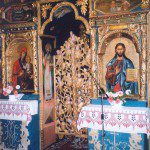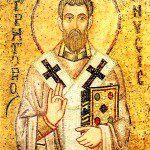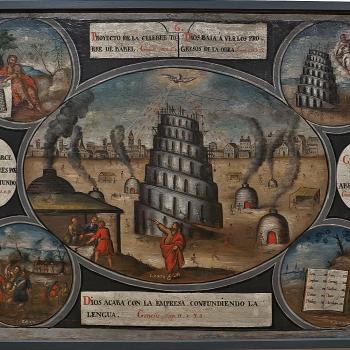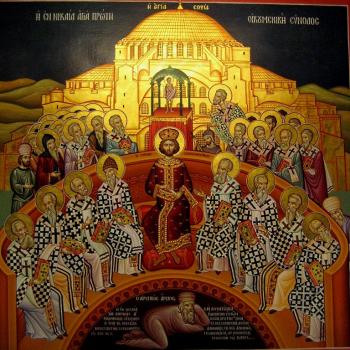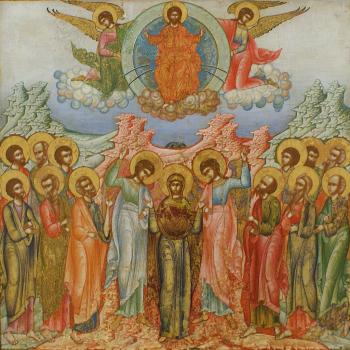Our living death, our constant death and rebirth in temporality, should serve to remind us not only of the death to come, but how death is able to bring about change, so that knowing what is to come, we truly will be ready for that change when we come to it. Life gives birth to death, death gives birth to change, change gives us the opportunity to change for the better. To affect that change in ourselves, we must accept the crucifixion of the self, detaching ourselves from what we think we are based upon what we were, so that we transcend what we were and become so much more thanks to the grace Jesus gives to us in death itself.
The God-man, Jesus, clearly participated in death, but his participation in death is different from the rest of us, because he did it for our sake, and not because he had any sin causing his own personal dissolution. He opened himself up to the human condition, including its living death, so that he could place death within himself, changing its ontological nature from within. It comes into him, bringing death and destruction, but as it is placed in his being, the Lord of Life, he now makes death the tool of life, where it can now be used to reverse the damage of sin, instead of what death had become, the tool of sin which sought to ferment the destruction of being caused by sin.
By death he conquered death. This must not be understood merely as the death he faced on the cross, though of course, it is the foundation for his work, but also the death he experienced each and every moment of existence, where, like the rest of us, he faced living death. Now the whole of human existence, from birth to its termination, including the death which is experienced moment to moment, should be included in the way we view his death conquers the destructive powers of death and makes it the bearer of life-saving grace.
And so, it is right to remember, the birth of Christ is connected with death, and so to commemorate death in the light of his birth is to remember why he was born. He took on the suffering which the pleasure of sin brings upon the sinner, without having undergone the sin, so that he can heal the damage done by sin, as St. Maximus the Confessor wrote:
That is why the Logos of God, being by nature fully God, became fully man, with a nature constituted like ours of a soul endowed with intellect and a body capable of suffering; only in His case this nature was without sin, because His birth in time from a woman was not preceded by the slightest trace of that pleasure arising from the primal disobedience. In His love He deliberately accepted the painful death which, because of pleasure, terminates human lie, so that by suffering unjustly He might abolish the pleasure-provoked and unjust origin by which this life is dominated.[6]
![Workshop of Peter Massacre of the Innocents by Paul Rubens [Public domain], via Wikimedia Commons](https://wp-media.patheos.com/blogs/sites/637/2016/12/0_Le_Massacre_des_Innocents_dapr%C3%A8s_P.P._Rubens_-_Mus%C3%A9es_royaux_des_beaux-arts_de_Belgique_2-300x223.jpg)
Then Herod, when he saw that he had been tricked by the wise men, was in a furious rage, and he sent and killed all the male children in Bethlehem and in all that region who were two years old or under, according to the time which he had ascertained from the wise men. Then was fulfilled what was spoken by the prophet Jeremiah:
“A voice was heard in Ramah, wailing and loud lamentation, Rachel weeping for her children; she refused to be consoled, because they were no more” (Matt. 2:16- 18 RSV)
The bearer of life has come into the world, and he brought about rebirth, the final rebirth of the resurrection, and once the resurrection was revealed, the irrational powers of sin fought back, exposing its strength is also its weakness as it showed all it could do is prepare someone for eternal glory through death:
Now when they heard these things they were enraged, and they ground their teeth against him. But he, full of the Holy Spirit, gazed into heaven and saw the glory of God, and Jesus standing at the right hand of God; and he said, “Behold, I see the heavens opened, and the Son of man standing at the right hand of God.” But they cried out with a loud voice and stopped their ears and rushed together upon him. Then they cast him out of the city and stoned him; and the witnesses laid down their garments at the feet of a young man named Saul. And as they were stoning Stephen, he prayed, “Lord Jesus, receive my spirit.” And he knelt down and cried with a loud voice, “Lord, do not hold this sin against them.” And when he had said this, he fell asleep (Acts 7:54-60 RSV)
Christ is born, and death is exposed. Christ is born to die, and so death is tied to his birth and ever present with us in the Christmas celebration. Without remembrance of such death, his birth itself would be incomplete, for without the remembrance of the death which leads to glory, we would easily forget the good which can come from death and we will fail to learn the lesson of Christ’s birth. Birth leads to death, but death need no longer be feared as the end; now death is to be embraced as the means by which our birth into eternity is established.
[1] The Kontakion for the Holy Innocents also remind us that the power of darkness was overturned already in Christ, which is why Herod acted in such aggression, “The King was born in Bethlehem./ The Magi came from the East with gifts./ They had been guided by a star./ But angry Herod mowed the children like wheat, lamenting that his power was destroyed.”
[2] The Kontakion for St. Stephen relates the two feasts together by saying: “Yesterday the Master came to us in the flesh,/ today His servant departs in the flesh;/ yesterday the King was born in the flesh;/ today His servant is stoned to death for His sake./ Hence the divine and first Martyr Stephen is made perfect.”
[3] St. Gregory Palamas, “Topics of Natural And Theological Sciences” in The Philokalia: The Complete Text. Volume IV. trans. G.E.H. Palmer, Philip Sherrard and Kallistos Ware (London: Faber and Faber: 1995), 371.
[4] St. Bonaventure, Breviloquium. trans. Erwin Esser Nemmers (London: B. Herder Co., 1946), 88.
[5] Nicodemus of the Holy Mountain, A Handbook of Spiritual Counsel. trans. Peter A. Chamberas (New York: Paulist Press, 1989), 125.
[6] St. Maximos the Confessor, “Fourth Century of Various Texts” in The Philokalia: The Complete Text. Volume II. trans. G.E.H. Palmer, Philip Sherrard and Kallistos Ware (London: Faber and Faber: 1990), 245.
Stay in touch! Like A Little Bit of Nothing on Facebook:
A Little Bit of Nothing


